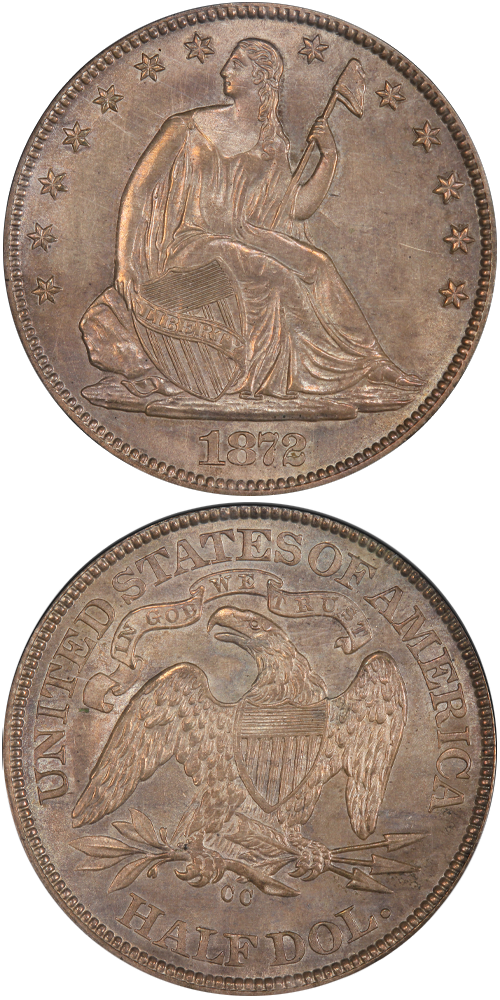1872-CC Liberty Seated Half Dollar
Jeff Ambio: Minor repunching within the upper inside loop of the digit 2 in the date, as well as a small die lump within the drapery above Liberty's foot. The reverse die exhibits a tiny raised dot on the scroll after the top of the letter N in the word IN, die cracks along the tops of the letters NIT in UNITED and along the base of the letters STA in STATES. The present example is also shelf doubled on many of the letters in the legend UNITED STATES OF AMERICA and the denomination HALF DOL.
Rusty Goe: While gold coin production continued to dominate the Carson Mint's output in terms of the face value of the pieces made in 1872, half dollars accounted for the largest quantity of coins delivered.
Over the past several decades, numismatists have deployed independent metallurgical chemists to analyze coins. When testing certain Carson City silver coins from 1871 and 1872, for example, it was discovered that the fineness of the precious metal was higher than the standard .900 as mandated by law -- sometimes substantially higher. It's possible that these revelations are not as groundbreaking as they appear.
According to a statement and a resolution in the February 1873 Assay Commission report, there was an "apparent discordance" between the records of the branch mint assay departments (Carson City specified) throughout 1872 and the test results of the Annual Assay Commission. The fineness of the silver ingots that were eventually used to make coins, as tested in the assay department of the Carson Mint, was "uniformly below that of the reserved coins" sent to the Assay Commission.
The Assay Commission's experts solved the riddle. When Assayer Hetrich recorded his fineness readings for the silver ingots, everything checked out to his satisfaction. But after the ingots turned into strips that were used to cut out blanks and then went through the pickling (or whitening) process, traces of the .100 fine copper alloy were removed, resulting in a higher fineness reading for the silver. This explanation satisfied the assay commissioners, who then resolved to close the matter.
Q. David Bowers: The need for coins of this denomination in the Western region continued, although the demand for silver dollars seems to have subsided to a very low point. Rusty Goe estimates that only 300 to 400 exist in all grades, with just eight to ten qualifying as Mint State and 50 to 75 in grades from EF to AU. The higher grade examples are definitely in the rarer class. Some half dollars may have been exported to there and then melted after arrival.
The example to the left was sold by Stack's Bowers Galleries in the Kennywood Collection, where it realized $39,100.






